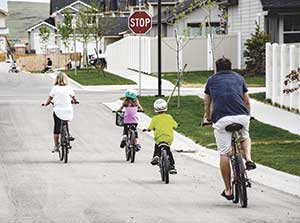
By Eileen Qiu
A comprehensive bicycle network plan with a goal to have 75 percent of work commutes happen without the use of cars in mind was discussed at a community meeting hosted by Director of Mobility Brad Rawson last Wednesday.
Surveys aimed at community engagement and cyclists were tasked with gathering data for reliable ways to get around and understand where the most practical areas for mobility are.
“We’re rolling up our sleeves together and strategically and transparently planning for the next couple of decades of safe and equitable mobility improvements across out city to make sure that all of our residents, workers and visitors have safe and useful and reliable ways to get around,” Rawson said.
A roadway of protected bike lanes separated from pedestrians with a strip of cobblestone would be nice to see wherever practical, Senior Planner of Mobility Viola Augustin said. She said roads in some areas are not wide enough for the vision and densely populated high traffic areas would have fewer travel options. However, the current model is just one design possibility for the network, she said. Street and reconstruction projects should consider bicycle, pedestrian and transit facilities whenever possible, she said.
In addition, there was also the goal to prioritize walking, biking and transit access while reducing miles travelled by cars, she said.
“The streets are for all of us. We have diverse ability needs, routines and preferences, and we have a responsibility to share these assets,” Rawson said.
The existing bike path in the city is about 13 miles long, with 5 miles of protected bike lanes, consultant Mike Lyndon said. In total, about 23 miles of non-vehicular paths exist in Somerville.
The most developed area is the southern part of the city where Union Square is, and the goal is to connect the less developed areas in the north, to the south, Lyndon said.
“There’s a very large opportunity for us to increase not just conductivity, but ridership overall,” Lyndon said.
Near crashes and heavy traffic in densely populated areas are all forms of ridership suppression that the team plans to combat through focusing on safety and making the community comfortable.
In the future, the Board will continue to conduct surveys to gather data in the spring and summer of 2022. There will also be a series of workshops and presentations to offer additional opportunities for community input.















Stop. Just stop. These people just need to stop. As it is now less than 3% of people commute via bicycle and that is higher than the actual % it is in winter months. We do not have a dependable transit system (the T is horrible), so the only safe and dependable method left is walking.
I’m a walker and even I am not willing to walk in the winter any further than 1.5 miles to a job – longer than that and it is not worth the effort. That leaves cars. We need car lanes and we need to stop this nonsense of pandering to select groups like the bike mafia.
^ Did you know that work commute trips are just 2 out of the 4 to 7 trips each working person makes? There are also so many trips that people who don’t work make. I see many people cycling for reasons other than going to or from work.
Just to be clear, and sorry for the heavy dose of reality, adding separated bike lanes is going to result in just about zero drivers choosing to bike instead of drive. 75% is about as absurd as planning out cities on mars. The decision to bike vs drive was made well beforehand, based on much more pressing criteria like distance, availability of parking at work, and general lifestyle (health / kids / type of job / etc ). In all the years I’ve biked around Somerville / Cambridge / Boston I never once chose to bike / not bike because of the quality of the ride. That just influenced the route I take. I‘d wager most new bikers are folks who would have walked or taken the T otherwise.
I’m a bike rider who doesn’t have an issue with traditional, non-separated bike lanes. I get more room to operate that way. Separated lanes can funnel you into trouble (e.g. someone steps in front of you and you’ve got nowhere to move or a car blocks you at an intersection).
That said, I’m all for new street designs. We ought to move parking off main roads to side streets (and I own a car too) in order to create more room for buses and bikes. I’d also like see more side streets turned into one-way roads so we can add green space and wider sidewalks. If it’s one-way, you don’t really need a bike lane.
Yet the main conflict on our roads is cars vs. cars. I’m not creating traffic as I zip past you on my bike. I don’t stop traffic by backing into a parking space. I’m not clogging intersections at cross streets. I’m not getting into fender benders with you.